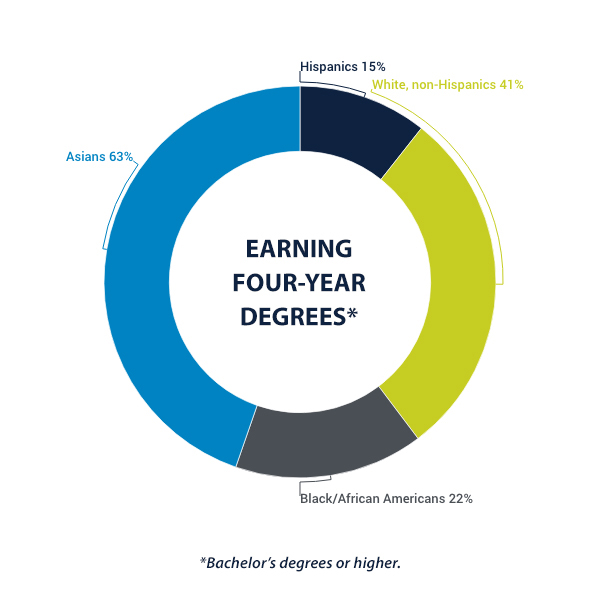
Focus on Hispanic High School/College Students Could Reverse Educational Slide in Our Country
The United States is no longer the top-ranking nation in terms of college degree attainment; the U.S. has the highest college dropout rate (estimated between 40 and 49 percent) among the industrialized nations.
In order for the U.S. to return to the top, Hispanics will need to earn 5.5 million degrees by 2020. The pressure on Hispanic educational attainment is due to the population growth in the Hispanic-American demographic.
By 2060, the United States population is expected to include 119 million Hispanics, up from 55 million in 2014. The good news is that significant college enrollment gains have been made among Hispanics, increasing three-fold between 1996 and 2012.
However, despite enrollment gains, Hispanics lag behind other groups in earning four-year degrees. Only 15 percent of Hispanics hold bachelor’s degrees or higher, compared to 63 percent for Asians, 41 percent for White, non-Hispanics, and 22 percent for Black/African Americans.

According to a cohort study of 2010 incoming undergraduates (the sample included a total of 924,251 students from 647 schools), more than half (51 percent) of college-bound Hispanics in the cohort enrolled in two-year public institutions – the highest of any ethnic group; and only 33 percent of those enrolled in two-year public institutions graduated within six years. The other 49 percent, who enrolled in four-year programs during the 2010 fall semester, saw a much better completion rate within six years – with 55 percent earning degrees.
The net result, unfortunately, is that a smaller percentage of Hispanics are obtaining bachelor’s degrees relative to other groups. The current undergraduate completion rate for Hispanic students in the 2010 cohort is 29.2 percent. More generally, while close to 70 percent of high school graduates in the United States enroll in college within two years, only 57 percent graduate within six years. For low-income and minority students, the completion rate is closer to 45 percent.
From there, the statistics become even more bleak.
Hispanics make up only 8 percent of graduate school enrollment, and only 17 percent of them enroll in business graduate programs. As a result, while Hispanics represent 17.6 percent of the population (as of July 2015), they hold fewer than 3 percent of senior positions at most major companies. The Fortune 100 has fewer than 5 percent of board seats allocated to Hispanics/Latinos, remaining relatively flat since 2004. The Fortune 500 companies have even less Hispanic representation, at 3.5 percent in 2017. The Hispanic market controls $1.3 billion in buying power, yet underrepresentation at the top threatens firms’ ability to attract this lucrative market.
Finally, relevant to Connecticut educators, the gap in educational attainment is even more pronounced in the business discipline. Nearly one in five bachelor’s degrees conferred in Connecticut are business degrees (as of 2012), yet Hispanics earn only 11 percent of them. With 14 percent of the population identifying as Hispanic, Connecticut has the eighteenth-largest Latino population in the country. Projections indicate this percentage will increase in the future, given that nearly one in five kindergarten students in Connecticut are Hispanic.
Like other states, the top enrolling undergraduate institutions in Connecticut are the community colleges, whose student body composition ranges from 18- to 28-percent Hispanic. The University of Connecticut is the top institution awarding bachelor’s degrees to Hispanics – 324 (or 6 percent) of the degrees conferred in 2011-2012 were awarded to Hispanic students.
Connecticut statistics are slightly better than the national trends: 20 percent of Hispanic adults have a bachelor’s degree in Connecticut, compared to 15 percent nationwide. Yet, graduation rates for Hispanics lag behind national rates (33 percent versus 51 percent), an alarming statistic. That suggests that nearly 67 percent of college enrolled Hispanics do not complete their undergraduate degree within six years.
Clearly, retaining Hispanic students and supporting them through graduation promises to pay significant economic dividends, and will help the U.S. reach top ranking in college-degree attainment among developed nations.
Moreover, as the population of Hispanic Americans continues to grow rapidly, educational attainment for Hispanics becomes an economic imperative. According to the U.S. Bureau of Labor Statistics, Hispanics will account for 80 percent of the total growth of the labor force from 2010 to 2050, doubling from 15 to 30 percent, and making up nearly one-third of all workers.
The National Center for Public Policy and Higher Education released a report in 2005 projecting that the skills of the workforce and the incomes of U.S. residents will decline over the next two decades if the education levels of the least well-educated portions of the population (Hispanics and Black/African Americans) are not increased significantly. In fact, the same report shows that the population group that will exhibit the greatest growth over the next few decades is also the least well educated: Hispanics.
The Excelencia in Education organization offers a database of initiatives that work in improving educational attainment for Hispanics. For example, the dual-enrollment program that is a result of a successful partnership between Hartford Public High School, Eastern Connecticut State University and Quinebaug Valley Community College has proven to be an effective strategy. The program has an 80 percent first- to second-year retention rate, which is equal to that for other incoming full- time freshmen. One of the keys to helping these students succeed is to have them live in university housing, an essential component of the dual enrollment program.
Below are additional suggestions that stem from the conversations that took place between attendees at the Diversifying Business by Enhancing Hispanic-American Educational Attainment: Insights for Business Schools, Employers, and Policy Makers summit held in April 2016:
- Consider the challenges from the students’ perspective. Students drop out due to cost of attendance (including fear of debt) and the difficulty in balancing work and school demands. Offering unique financial packages or payment plans, and offering flexible schedules via online and hybrid programs may help alleviate the stress of competing priorities and financial burden.
- Improve the linkage between two-year and four-year institutions. More than half of Hispanic students attend two-year institutions, and do not transfer to earn bachelor’s degrees. Providing pathways that help ensure students are not only aware and willing, but also very prepared to transition to a four-year institution could significantly increase the number and success of transfer students.
- Increase the number of Hispanic faculty. Hispanic faculty are only 2.3 percent of business school faculty. Alarmingly, Hispanic representation is also considerably low in one potential faculty pipeline – graduate assistants. In 2011, Hispanics represented 4 percent of graduate assistants, compared to Whites (50 percent), Asians (7 percent), and Black/African Americans (4 percent).
Yet, researchers (www.phdproject.org) have found a positive relationship between the presence of teachers of color and the achievement of all students; Hispanic faculty contribute to a positive campus climate for Hispanic students and that more supportive climates are related to better retention and graduation rates for these students.
Cinthia Beccacece Satornino is an assistant professor of marketing at the University of Connecticut School of Business. Last year she participated in a White House educational initiative to assist Hispanic students in completing their education, and was an invited panelist at the Fulfilling America’s Future: Latinas in the U.S. summit held at the White House in October of 2016.